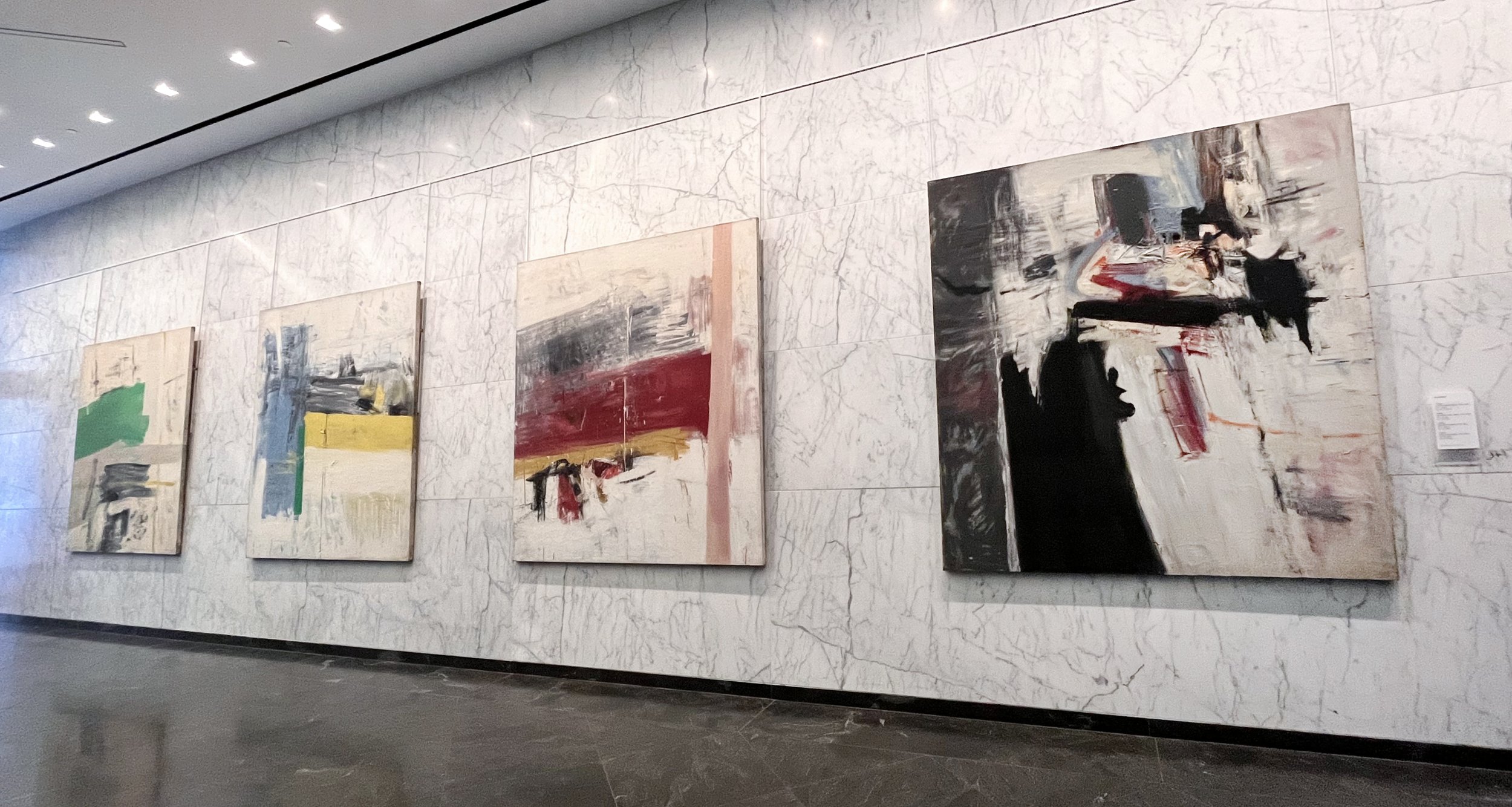The Lobby Gallery at 499 Park Avenue presents Back on Park, an exhibition of six paintings by celebrated abstract expressionist Alan Fenton, through January 2024. Produced in partnership with Lincoln Glenn Gallery, the exhibition is accompanied by a brochure featuring an essay by Jeffrey Wechsler.
Essay by Jeffrey Wechsler
Arriving to New York City from Cleveland in 1955, Alan Fenton (1927 – 2000) dove enthusiastically into the boisterous, burgeoning world of Abstract Expressionism, interacting socially and professionally with its practitioners and studying under two of them: Adolph Gottlieb and Jack Tworkov. In the late 1950s, Abstract Expressionism was firmly recognized and entrenched within the contemporary American art world as the style that shifted the international center of fine art from Paris to New York. Indeed, by the late fifties, emerging artists of the style were already considered part of its second generation. Independently, or through trends supported by many art schools and museums, hundreds of artists nationwide entered the Abstract Expressionist tidal wave, each attempting to forge a personal vision.
Within that context, Fenton sought his own pathways. Perhaps through an appreciation and evaluation of the major approaches to abstraction that previously evolved, Fenton often traveled along multiple, rather diverse stylistic roads. These included many works on paper, with abstract imagery of a wide range, for example: somber, stacked bands of black; nearly monochrome, delicate acrylic washes of transparent tones; and active surfaces energized by welters of zigzagging pencil lines. The exhibition Alan Fenton: Back on Park focuses on what might be considered Fenton’s mainstream Abstract Expressionist painting style. The works touch on fundamental modes of Abstract Expressionist picture-making, such as the gestural so-called “action painting” of Willem de Kooning, Jackson Pollock, and Jack Tworkov, or the color fields of Mark Rothko and Barnett Newman. However, the particular group of paintings on view at 499 Park resonate with a manner exemplified by Clyfford Still, James Brooks, and many others, in which abutting, irregular color shapes––often with textural emphasis––jostle and interact with each other, occasionally in eccentric ways. Such works may be large or small, featuring either clearly defined or blending edges of color areas. The overall composition and pictorial interest are created by the intricate positioning of visual elements and effects of varied color schemes.
Of course, the immediate impact of this specific set of paintings is derived from their size. Often over eight feet high or wide, they confront the viewer, virtually hovering and looming before them with a presence that commands attention. Even within the scope of Abstract Expressionism, known for large scale works, many artists of the style did not often attempt these dimensions within their output, if at all.
With Fenton’s penchant for developing personal approaches to abstract picture-making, it is not surprising to discover––even within this small selection of six paintings––a considerable array of unusual motifs and combinations of techniques that ultimately form a rather open-ended, yet implicitly individual style. To demonstrate this, perhaps the most prominent motif to explore is Fenton’s use of very long stripes of color, varying from narrow lines to wide bands that slash through the compositions, sometimes from one opposing border to the other. These may move through the central areas of the work, or they may nudge up so close to an edge as to leave merely a sliver of painted surface virtually cut off from the rest of the surface––a compositional orphan, as it were. The latter type, admirably illustrated by Untitled (vertical pink stripe), shows Fenton laying down a pictorial device so compositionally outrageous that he seems to be challenging himself to find a way to integrate it into a workable, visually satisfactory final image. To do so, Fenton’s big stripe is a pale, neutral pink, reducing its immediate impact. The central horizontal red band subtly intrudes past the pink stripe, linking the white edge to the bulk of the painting. The painting’s large upper and lower white areas visually interact with the white edge; in unison, they form a squared-off reverse letter-C shape, which encloses everything else in the composition, containing it as if grasped by a C-clamp or vise. In contrast, the slender white drip at the center does remarkable compositional duty for its relative delicacy, becoming the true dividing line and visual pivot for the entire painting.
Such careful manipulation of stripes, edges, and overall surface forms is also seen in Untitled (vertical gray stripe) and Untitled (vertical green stripe), where stripes––either thick or thin, whether isolating an edge or becoming an isolated edge themselves––somehow find their proper place through Fenton’s quirky yet effective methods. They include surprising and delightful bits of technique, reflecting the full range of Abstract Expressionist painterly options. In Untitled (crossing yellow stripes), one finds two small adjacent areas at the bottom center––one is a delicate and complex area of spatters, smears, and dripped snippets of yellow, pink, blue, gray and white; another is an abstract tumbleweed of compressed, jumbled strokes in a muted spectrum. These oddly appealing details are potentially overlooked by viewers but should be sought out for their inventiveness and interest––rather like Alan Fenton himself, whose exploratory nature and output should be more widely studied and appreciated for his often under-the-radar contribution to the Abstract Expressionist era.
Jeffrey Wechsler
Jeffrey Wechsler was Senior Curator of the Jane Voorhees Zimmerli Art Museum of Rutgers University until his retirement. He specializes in lesser-known but worthy artists and styles within 20th-century American Art, organizing exhibitions such as “Surrealism and American Art: 1931-1947” and “Asian Traditions / Modern Expressions: Asian American Artists and Abstraction, 1940-1970.”

